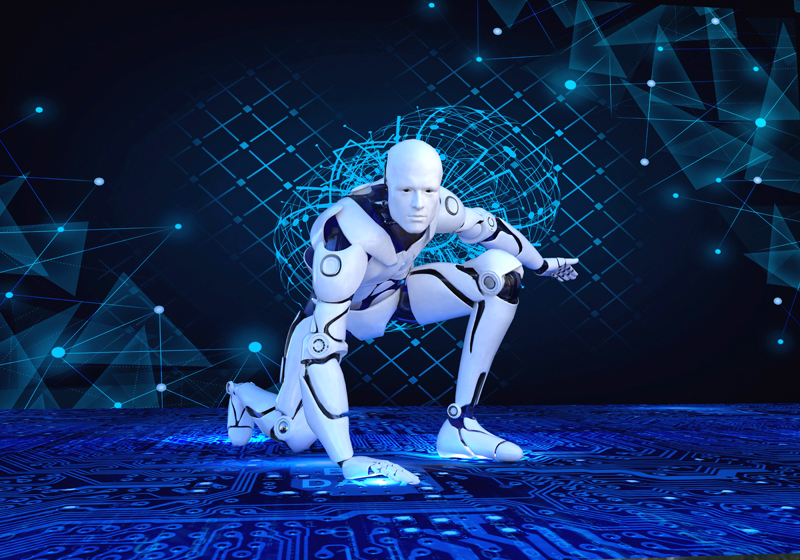Home >Technology peripherals >AI >Why are humanoid robots so popular?
Why are humanoid robots so popular?
- WBOYWBOYWBOYWBOYWBOYWBOYWBOYWBOYWBOYWBOYWBOYWBOYWBforward
- 2024-04-28 11:37:331035browse

#With the rapid advancement of technology and the integration of artificial intelligence (AI) in many aspects of our lives, humanoid robots have become a new and popular innovation. Due to their ability to interact, learn, and perform tasks autonomously, these humanoid robots are increasingly in demand across a variety of industries, including entertainment, hospitality, healthcare, and education. This article reveals why humanoid robots are needed.
Why are humanoid robots needed? To understand this, it is important to understand what is driving their demand. One reason is their ability to augment and automate human labor, humanoid robots are transforming industries and are in high demand. As artificial intelligence, advanced machinery and sensor technology develop, these robots will become more sophisticated and capable of tasks normally performed by humans. For example, humanoid robots equipped with precise sensors and artificial intelligence algorithms streamline production, increase efficiency, and reduce labor costs in manufacturing. It succeeds in completing tasks more efficiently and improves the health of the work environment. As a result, organizations can intensify their activities, allocate human resources more decisively, and achieve higher levels of results and quality. Humanoid robots play a central role in driving innovation and progress across industries, a trend that reflects the shift toward a more automated and efficient future.
Additionally, the second most important reason why humanoid robots are in demand is their increasing popularity in the healthcare services industry due to their ability to assist clinical experts and improve patient consideration. Given the aging population and growing demand for medical services, humanoid robots offer new ways to address labor shortages and improve healthcare. Humanoid robots provide invaluable assistance in daily exercise and medical services, from medication advice to active rehabilitation exercises to assist the elderly or disabled. These robots can also help with medical procedures, analyze patient data, and act as virtual medical assistants for personalized support and care. Humanoid robots are transforming healthcare delivery and improving patient outcomes by filling critical gaps in healthcare delivery, increasing efficiency. As innovation continues to advance, the potential for humanoid robots to transform medical care and provide compassionate, open-minded consideration for humans is vast and promising.
All things considered, in school education, humanoid robots are being taught to be intelligent and provide opportunities for students to grow. With their humanoid structural characteristics and expressive capabilities, these robots can become powerful educational devices, stimulating students' interest, creative thinking and clear thinking skills. Teachers can be provided with illustrations, exhibits, and individualized instruction for each student. The humanoid robot can also be used as an intuitive teacher, using NLP and artificial intelligence calculations to adjust the speed and style of its assistance to meet the needs of each student. Through virtual simulation and augmented reality experiences, humanoid robots can also create immersive learning environments that allow students to engage with STEM concepts first-hand.
In theme parks and entertainment venues, humanoid robots entertain visitors with lifelike movements, expressions and performances, adding excitement and interactivity to the visitor experience. Humanoid robots are used as waiters, receptionists and concierge assistants in hotels and restaurants to provide guests with personalized service, information and assistance. Businesses in the hospitality industry benefit from the efficiency of these robots, lower labor costs and higher customer satisfaction.
The growing recognition of humanoid robots can be attributed to their growing popularity for their ability to handle socially demanding situations and increase lifestyle satisfaction. From assisting people with disabilities to assisting in difficult response efforts, humanoid robots are deployed in many humanitarian applications to provide assistance, relief and guidance to those in need. For example, humanoid robots equipped with walking aids and assistive devices can perform daily activities and participate more fully in society. These efforts range from assisting people with disabilities to supporting disaster relief efforts. Likewise, humanoid robots equipped with sensors and cameras can assist emergency responders in search and rescue missions, helping find survivors in disaster zones and deliver supplies to remote or inaccessible areas. These are some of the reasons why humanoid robots are in demand and explain why humanoid robots are needed.
Summary
The growing demand for humanoid robots can be attributed to their versatility, adaptability, and potential to revolutionize various industries and sectors of society. Humanoid robots are poised to play an important role in shaping work, education, healthcare, entertainment, and companionship in a variety of ways, including automating daily tasks and improving efficiency, assisting medical professionals, and serving guests.
The above is the detailed content of Why are humanoid robots so popular?. For more information, please follow other related articles on the PHP Chinese website!
Related articles
See more- Artificial Intelligence Classification
- What are the main applications of artificial intelligence in education?
- U.S. startup Figure raises $70 million to build universal humanoid robot
- Tesla humanoid robot mass production in 2024 Q1?
- Kepler humanoid robot officially released, with hard-core technology blessing ushering in a new era of co-creation of robots

